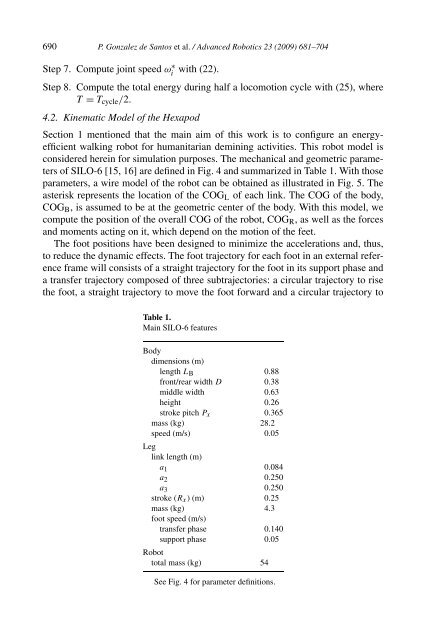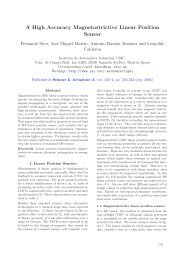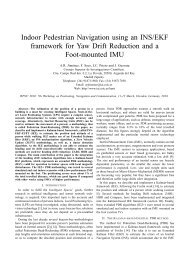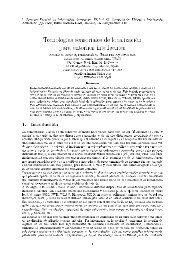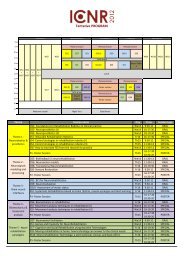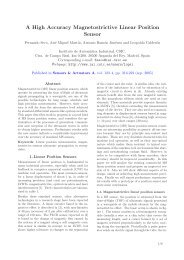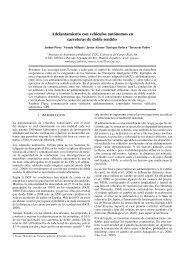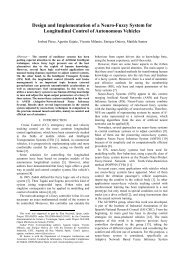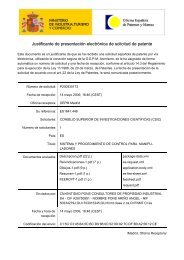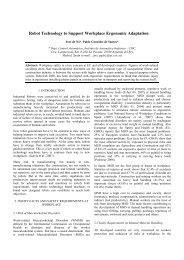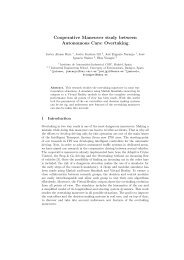Full paper Minimizing Energy Consumption in Hexapod Robots
Full paper Minimizing Energy Consumption in Hexapod Robots
Full paper Minimizing Energy Consumption in Hexapod Robots
Create successful ePaper yourself
Turn your PDF publications into a flip-book with our unique Google optimized e-Paper software.
690 P. Gonzalez de Santos et al. / Advanced Robotics 23 (2009) 681–704Step 7. Compute jo<strong>in</strong>t speed ωi ∗ with (22).Step 8. Compute the total energy dur<strong>in</strong>g half a locomotion cycle with (25), whereT = T cycle /2.4.2. K<strong>in</strong>ematic Model of the <strong>Hexapod</strong>Section 1 mentioned that the ma<strong>in</strong> aim of this work is to configure an energyefficientwalk<strong>in</strong>g robot for humanitarian dem<strong>in</strong><strong>in</strong>g activities. This robot model isconsidered here<strong>in</strong> for simulation purposes. The mechanical and geometric parametersof SILO-6 [15, 16] are def<strong>in</strong>ed <strong>in</strong> Fig. 4 and summarized <strong>in</strong> Table 1. With thoseparameters, a wire model of the robot can be obta<strong>in</strong>ed as illustrated <strong>in</strong> Fig. 5. Theasterisk represents the location of the COG L of each l<strong>in</strong>k. The COG of the body,COG B , is assumed to be at the geometric center of the body. With this model, wecompute the position of the overall COG of the robot, COG R , as well as the forcesand moments act<strong>in</strong>g on it, which depend on the motion of the feet.The foot positions have been designed to m<strong>in</strong>imize the accelerations and, thus,to reduce the dynamic effects. The foot trajectory for each foot <strong>in</strong> an external referenceframe will consists of a straight trajectory for the foot <strong>in</strong> its support phase anda transfer trajectory composed of three subtrajectories: a circular trajectory to risethe foot, a straight trajectory to move the foot forward and a circular trajectory toTable 1.Ma<strong>in</strong> SILO-6 featuresBodydimensions (m)length L B 0.88front/rear width D 0.38middle width 0.63height 0.26stroke pitch P x 0.365mass (kg) 28.2speed (m/s) 0.05Legl<strong>in</strong>klength(m)a 1 0.084a 2 0.250a 3 0.250stroke (R x ) (m) 0.25mass (kg) 4.3foot speed (m/s)transfer phase 0.140support phase 0.05Robottotal mass (kg) 54See Fig. 4 for parameter def<strong>in</strong>itions.


